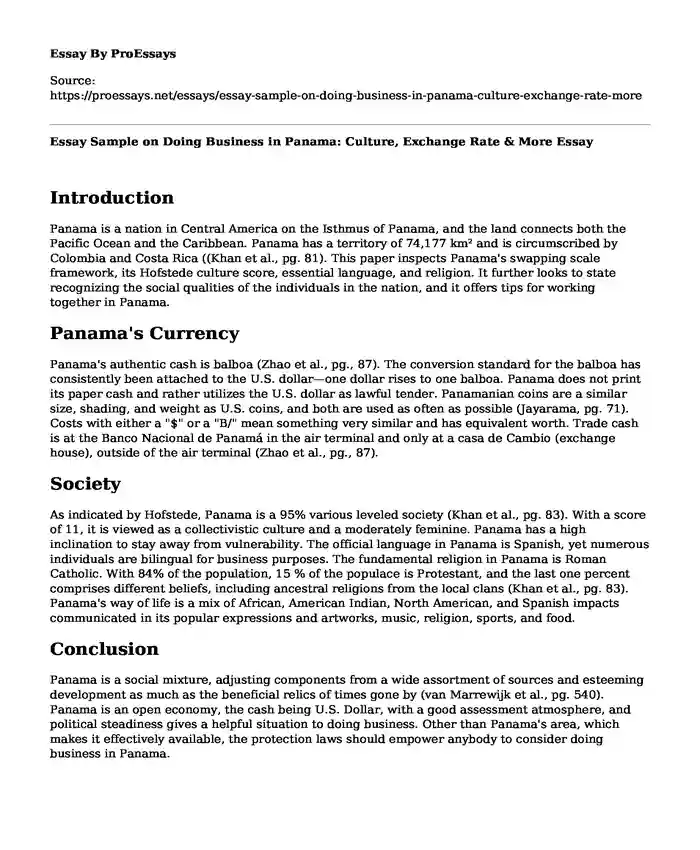Introduction
Panama is a nation in Central America on the Isthmus of Panama, and the land connects both the Pacific Ocean and the Caribbean. Panama has a territory of 74,177 km² and is circumscribed by Colombia and Costa Rica ((Khan et al., pg. 81). This paper inspects Panama's swapping scale framework, its Hofstede culture score, essential language, and religion. It further looks to state recognizing the social qualities of the individuals in the nation, and it offers tips for working together in Panama.
Panama's Currency
Panama's authentic cash is balboa (Zhao et al., pg., 87). The conversion standard for the balboa has consistently been attached to the U.S. dollar—one dollar rises to one balboa. Panama does not print its paper cash and rather utilizes the U.S. dollar as lawful tender. Panamanian coins are a similar size, shading, and weight as U.S. coins, and both are used as often as possible (Jayarama, pg. 71). Costs with either a "$" or a "B/" mean something very similar and has equivalent worth. Trade cash is at the Banco Nacional de Panamá in the air terminal and only at a casa de Cambio (exchange house), outside of the air terminal (Zhao et al., pg., 87).
Society
As indicated by Hofstede, Panama is a 95% various leveled society (Khan et al., pg. 83). With a score of 11, it is viewed as a collectivistic culture and a moderately feminine. Panama has a high inclination to stay away from vulnerability. The official language in Panama is Spanish, yet numerous individuals are bilingual for business purposes. The fundamental religion in Panama is Roman Catholic. With 84% of the population, 15 % of the populace is Protestant, and the last one percent comprises different beliefs, including ancestral religions from the local clans (Khan et al., pg. 83). Panama's way of life is a mix of African, American Indian, North American, and Spanish impacts communicated in its popular expressions and artworks, music, religion, sports, and food.
Conclusion
Panama is a social mixture, adjusting components from a wide assortment of sources and esteeming development as much as the beneficial relics of times gone by (van Marrewijk et al., pg. 540). Panama is an open economy, the cash being U.S. Dollar, with a good assessment atmosphere, and political steadiness gives a helpful situation to doing business. Other than Panama's area, which makes it effectively available, the protection laws should empower anybody to consider doing business in Panama.
Works Cited
Zhao, Hong-Yan, Jong-Wook Kwon, and Oh-Suk Yang. "Updating Hofstede's Cultural Model and Tracking Changes in Cultural Indices." Journal of International Trade & Commerce 12.5 (2016): 85-106. https://papers.ssrn.com/Sol3/papers.cfm?abstract_id=2953330
Khan, Raihan, and Pamela Cox. "Country culture and national innovation." Archives of Business Research 5.2 (2017): 81-115
http://116.203.177.230/index.php/ABR/article/view/2768
Jayaraman, Tiruvalangadu K. "Reforms in exchange rate arrangements: is there a case for a currency board in Vanuatu?." (2019): 66-125
https://openresearch-repository.anu.edu.au/handle/1885/157632
Van Marrewijk, Alfons, and Karen Smits. "Cultural practices of governance in the Panama Canal Expansion Megaproject." International journal of project management 34.3 (2016): 533-544.
https://www.sciencedirect.com/science/article/abs/pii/S0263786315001143
Cite this page
Essay Sample on Doing Business in Panama: Culture, Exchange Rate & More. (2023, Sep 25). Retrieved from https://proessays.net/essays/essay-sample-on-doing-business-in-panama-culture-exchange-rate-more
If you are the original author of this essay and no longer wish to have it published on the ProEssays website, please click below to request its removal:
- Legal Advice for Business - Paper Example
- Paper Example on Mao Zedong and China's Revolution
- Race Relation in America Has Gotten Better Since Dr.King Delivered His Speech "I Have A Dream" Essay
- Literary Analysis Essay on The Indian Country
- Essay Example on Gender Parity: From Traditions to Equality
- Paper Example on Nurse Julia Brown: Helping the Needy in Africa
- Paper Sample on Family Problems: Trey's Struggles of a Divorced Home







